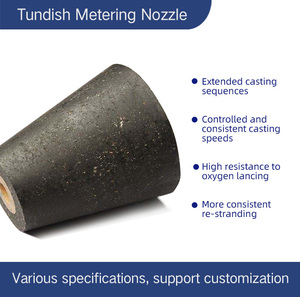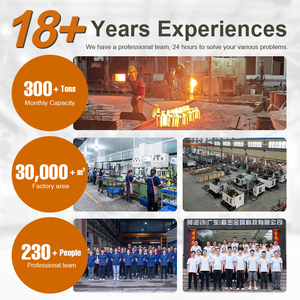
All categories
Featured selections
Trade Assurance
Buyer Central
Help Center
Get the app
Become a supplier

(678 products available)













A continuous casting tundish is partitioned into multiple parts. They are further distinguished into several categories based on operational needs and how metal flows within them. Tundishes like these include:
The two main types are operational and based on metal flow. The operational ones include:
Distribution tundish
A distribution tundish is used to ensure that molten metal is evenly spread to the various molds during the continuous casting process. Such tundishes have runners or channels that assist in directing the molten metal flow to each mold. The design of a distribution tundish is usually dictated by the specific casting requirements and the nature of the metal being cast.
Stirring tundish
Stirring tundishes are used when there is a need to keep molten metal in a stable fluid state, especially where there are risks of it becoming solid due to lower temperatures at certain mold sections. Such tundishes mostly make use of stirring mechanisms, either electromagnetic or mechanical, to ensure that the molten metal is consistently mixed and the temperature as well as the composition are set right.
The two operational based distribution focuses metal alloy service temperature stability, directing metal to intended casting molds. Balance tundishes normally used where casting process sees fluctuation in metal need. They help in redistributing casting line where there's insufficient supply. Balance casting molds features integration that redirects flow toward deficient mold.
Flow-type tundishes such as active, passive, and semi-active ones are defined by metal flow. Active flow-type tundishes are those that incorporate elements such as weirs and dams that actively control flow and may also include filters to remove impurities. Passive flow-type tundishes do not have significant flow control mechanisms, while semi-active only feature few flow control elements. Optimal creation of thin films within these tundishes depends largely on their structures. This helps to mitigate the likelihood of inclusions by promoting the formation of an appropriate amount of films that will eliminate filling defects. The designs are also significant in improving the residence time of the molten metal. Deep pools and long flow channels are thus ideal for increasing time.
Continuous casting tundishes are made using several key elements. They include:
Structural strength and integrity are provided by walls. They are tasked with holding the molten metal in place while providing insulation to minimize heat loss. Thermal conductivity of the materials used in the manufacturing of the walls ought to be low to enhance insulation. Cast refractories or high alumina bricks are generally used to construct tundish walls. These have low thermal conductivity and thus enhance insulation.
The pouring basin is situated at the tundish's upstream section. It enables molten metal to be poured into the tundish from the furnace. It acts as the initial holding area and helps in distributing metal to the various runners. Its design influences how metal flows within the tundish. For optimal performance, the basin should have a sufficient volume and optimal design to minimize turbulence.
Runners are channels within the tundish that guide molten metal to the various molds. How they are designed directly influences metal flow. Wider runners tend to offer lower resistance to flow, while narrower ones increase the likelihood of D pressures within the mold. To reduce the risk of filling defects in the casting process, a proper runner design should be put in place.
Weirs are structures situated at the tundish's exit. They play a major role in controlling the molten metal's flow. Metal flows over weir tops, while molten metal flows below it. Adjusting weir heights provides flexibility in controlling the flow rate and metal level, which has significant effects on how stable the casting operation is.
Continuous casting tundishes have a variety of applications in several industry sectors. Here are these major industry applications:
In the steel industry, tundishes are commonly found in large-scale steel production facilities. They control the flow of molten steel during the casting process. By ensuring that the right amount of metal goes to each mold, they help enhance product quality by getting rid of impurities. This is especially important in the making of high-strength steel which necessitates low impurity content.
Tundishes are also used in the casting of copper, aluminum, and other non-ferrous alloys in non-ferrous metal production. They help maintain the right temperature and flow of metal during the casting of lighter metals.
Automotive industries mostly utilize steel and aluminum components. The major alloy casting process used by this industry is the continuous casting. This continuous casting allows the industries to attain large volumes of production while still maintaining the quality required in this industry.
In the aerospace industry, where materials need to be lightweight yet ultrastong, tundishes come in handy during the continuous casting of elite materials. The industries have to achieve a high level of precision and purity. This makes tundishes play a particularly important role because any defect can lead to failure in the aircraft components.
Both nuclear and renewable energy sources sectors use alloys with high strength and excellent corrosion resistance, such as those made of stainless steel. These industries therefore also utilize tundishes in the continuous casting process to achieve these materials.
A few important criteria should be considered when selecting continuous casting tundishes to provide the best possible performance. Here are these criteria:
Type
The type of tundish to use is one of the most important factors to consider. The function of the casting tundish will have implications for its type. Distribution and balance tundishes will be ideal for enhancing metal distribution in casting lines where there is a large demand. Stirring tundishes will be a good choice when there is a need to maintain alloy homogeneity and temperature. Flow-type tundishes that feature active components like filters for inclusions will be ideal in processes that require improved quality.
Size and capacity
The required size and capacity of a tundish are determined by the casting line's demands. Casting speed, metal type, and mold number are factors that every modern industry has to take into account when sizing a tundish. Larger tundishes provide longer residence time and are ideal for high-capacity casting lines. Small tundishes, on the other hand, are more appropriate for small-scale operations.
Material
Continuous casting goes on to demand that molten metal be contained within a tundish. To minimize interactions between the metal and the tundish, the materials used to construct tundishes should be as sturdy as possible. Common materials used for construction include cast refractories, high alumina bricks, and stainless steel. Stainless steel is commonly used in non-ferrous metallurgy due to its strength and resistance to corrosion.
Design features
Specific design elements such as weirs, pour basins, and runners affect a tundish's efficiency in operation. A design with adjustable weirs provides operational flexibility. Elaborate runner systems aid in even distribution. Filtration systems integrated into the design eliminate impurities. Deep pour basins enhance metal quality further. A well-designed tundish contributes to sustainability by reducing energy consumption and emissions.
Maintenance and durability
One of the most manufactured items in the world is the continuous casting tundish.The casting tools themselves need to be tough because the casting tools are comprised of metals that are extremely tough to make. This mineral has an extremely low thermal conduction, making it ideal for binding the casting metals together as they cool.Tundish maintenance allows for more frequent operational changes to be made, such as the addition or removal of metals, which could reduce operational costs.The casting tools can be dismantled and transported to other places with the least amount of effort. This quality also makes transport and storage easy, offering enhanced transportability for industries that need to shift their tundish frequently.
A1: It is a reservoir that distributes molten metal to molds during continuous casting in metal production.
A2: Pour basin, runners, and weirs are the major components, guiding and controlling molten metal flow.
A3: Tundishes are mostly made of high-grade steel, cast refractories, or high alumina bricks for durability and insulation.
A4: It resists corrosion, making it ideal for non-ferrous industries where casting metals might corrode other materials.
A5: They decrease impurities and stabilize metal composition through stirring or filtration, enhancing overall quality.
A6: Weirs regulate molten metal level and flow rate, ensuring consistent outflow for stable casting processes.